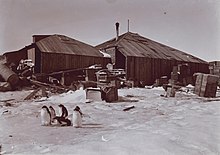Australasian Antarctic Expedition
The Australasian Antarctic Expedition, or unofficially Aurora Expedition, was an Australian scientific expedition whose members explored part of Antarctica between 1911 and 1914 . It was led by the Australian geologist Douglas Mawson , who was later knighted for his services in leading this expedition. In 1910 Mawson began planning an expedition to map the two thousand kilometers of Antarctica's coastline south of Australia. The Australasian Association for the Advancement of Science applauded his plans and contributed significantly to the funding of the expedition. The remaining funds were raised through public support.
The team selected for the expedition came mainly from Australian and New Zealand universities. Of the men who were supposed to man bases on the Antarctic continent, 22 were Australian citizens. Four were New Zealanders, three were British and one was Swiss. Three of the guides (Mawson, Frank Wild, and John King Davis ) were veterans from previous Antarctic voyages.
The intended ship was the seal-hunting ship Aurora from Newfoundland , a steam-powered sailing ship with a length of almost 50 meters and a displacement of 600 tons. The ship underwent some modifications for the journey, including the addition of three large tanks for fresh water storage. The captain of the Aurora was John King Davis .
The ship left Hobart harbor for Macquarie Island on December 2, 1911, and arrived there on December 11 after weathering stormy weather. A second ship, the Toroa , followed with food and passengers. On December 23, the Aurora left Macquarie Island and began exploring the coastal areas, discovering and naming George V Land and Queen Mary Coast .
The men set up their main base or winter quarters at Mawson's Huts on Cape Denison in Commonwealth Bay , where eighteen men spent the winter of 1912 and seven the winter of 1913. Their huts are still standing, two intact and two in ruins. They also built quarters on Macquarie Island and a western base on the Shackleton Ice Shelf , but these no longer exist today.
The teams at all three bases carried out routine scientific and meteorological observations, which were detailed in the extensive reports published between 1922 and 1942. They also weathered months of equipment and mast failure when they set up Antarctica's first wireless radio link, which linked to Hobart.
Sleigh rides on the coast and inland gave the crew the opportunity to explore previously unknown territory. In the second half of 1912, five major trips were made from the main base and two from the west base.
On one such sleigh ride, led by Mawson and on which the dogs were driven by Xavier Mertz and Belgrave Ninnis , Ninnis, a team of six dogs and the sleigh with most of the food fell into a crevasse. The survivors began a brutal journey home to base camp 500 kilometers away, where they fed on the remaining dogs. Mertz fell into delirium and died on the way back, leaving Mawson as the only survivor. He cut his sledge in half with a penknife and then pulled it 160 kilometers back to the base at Cape Denison with geological samples and very little food. He arrived there on February 8, 1913, just hours after Davis' rescue crew pulled back on the Aurora , and was nursed to health while staying with six volunteers for another, this time unplanned, year. Mawson documents this tough journey in his book "The Home of the Blizzard".
Other members of the expedition were Frank Hurley as official photographer, Frank Wild as leader of the west base, Charles Hoadley as geologist and Cecil Madigan as meteorologist.
See also
literature
- Douglas Mawson: The Home of the Blizzard Being the Story of the Australasian Antarctic Expedition, 1911-1914 . William Heinemann, London 1915, Vol. I and Vol. II (accessed on May 26, 2010).
- David Roberts: Alone on the Ice. The Greatest Survival Story in the History of Exploration . Norton, New York 2013, ISBN 978-0-393-24016-0


